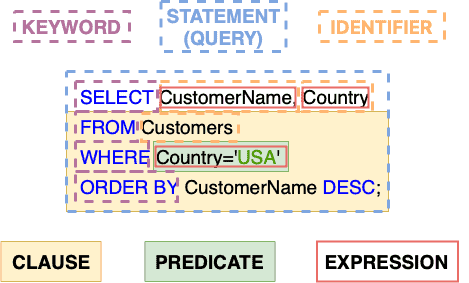1. Introduction
Structured Query Language, better known as SQL, is a standard language for managing and manipulating databases. It allows us to access, manipulate, and control data stored in relational databases. SQL has a wide range of elements, including queries, statements, clauses, expressions, and predicates.
In this tutorial, we start by introducing all the elements in SQL. Then, we’ll concentrate on two of these elements: SQL queries and statements. We’ll explore their distinctions and give useful examples for each.
2. SQL Syntax and Language Elements
SQL is a declarative language, meaning we tell it what we want, and it figures out how to do it. It includes a variety of elements to construct commands. There are seven key elements in SQL:
- Keywords are reserved words that have a special interpretation in SQL. Common examples include SELECT, INSERT, UPDATE, DELETE, WHERE, and FROM
- Identifiers refer to the names of database objects, such as tables and columns
- Expressions are combinations of one or more values, operators, and SQL functions that evaluate a single value
- Queries use certain criteria to retrieve data, which is a crucial component of SQL
- A statement is any command or instruction given to a relational database management system using SQL. This command can serve a variety of purposes, such as retrieving data, updating data, or modifying the database structure
- Clauses are a component of SQL queries and statements. For instance, WHERE, ORDER BY, and GROUP BY are some of the popular clauses used in SQL
- Predicates specify the circumstances that SQL judges as true, false, or unknown. These circumstances may reduce the impact of SQL statements and queries or change the way programmers run
The figure below illustrates the key elements of SQL:

3. Difference Between Query and Statement
Sometimes people use the terms SQL statement and SQL query interchangeably, but they have distinct meanings.
3.1. SQL Statements
An SQL statement is a command that can be issued to the database for various tasks such as retrieving data, updating data, or manipulating the database structure.
SQL statements include queries (commands for retrieving data) but also encompass a wider set of operations, including:
- INSERT: Adds new data (rows) to a table
- UPDATE: Modifies existing data within a table
- DELETE: Removes data from a table
- CREATE: Creates a new database object, such as a table or view
- ALTER: Modifies an existing database object
- DROP: Deletes a database object
Each of these statements helps users interact and manipulate the data and the structure of the database in different ways, making SQL a flexible and powerful language for managing relational databases.
For example, an INSERT statement might look like this:
INSERT INTO Customers (CustomerName, ContactName, Country)
VALUES ('Cardinal', 'Tom B. Erichsen', 'Norway');
In this example, the INSERT statement adds a new row of data to the ‘Customers’ table.
3.2. SQL Queries
SQL queries are a subset of SQL statements that return data based on specific criteria. They are used specifically to retrieve data from the database, and they do this using the SELECT statement. For example, a simple SQL query might look like this:
SELECT CustomerName, Country
FROM Customers
WHERE Country='USA';
In this example, the query selects and returns all customers from the ‘Customers’ table based in the USA.
In essence, all queries are statements, but not all statements are queries. A query is a statement that retrieves data, while statements can do this and much more, including modifying data and altering the database structure.
4. Conclusion
In this article, we talked about the elements of SQL, including keywords, identifiers, expressions, queries, statements, clauses, and predicates. It is often to mix up statements and queries. However, they do have distinct meanings and serve different purposes. Understanding the distinction between SQL statements and queries is essential for anyone working with SQL.
A query is a statement that specifically retrieves data and helps clarify their unique roles within the SQL language. On the other hand, statements include a broader set of operations, such as INSERT, UPDATE, DELETE, CREATE, ALTER, and DROP.